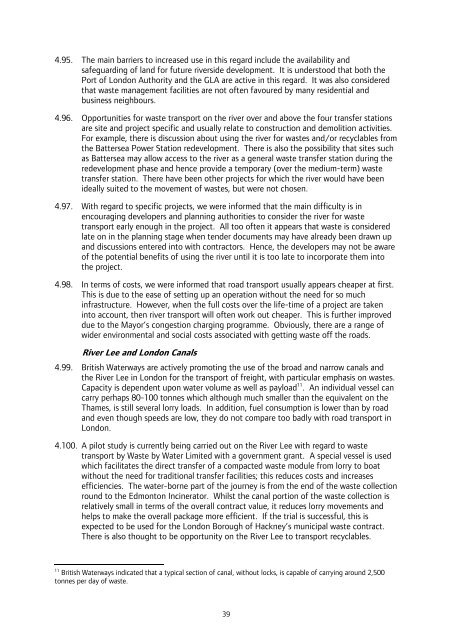London Wider Waste Strategy - London - Greater London Authority
London Wider Waste Strategy - London - Greater London Authority
London Wider Waste Strategy - London - Greater London Authority
You also want an ePaper? Increase the reach of your titles
YUMPU automatically turns print PDFs into web optimized ePapers that Google loves.
4.95. The main barriers to increased use in this regard include the availability and<br />
safeguarding of land for future riverside development. It is understood that both the<br />
Port of <strong>London</strong> <strong>Authority</strong> and the GLA are active in this regard. It was also considered<br />
that waste management facilities are not often favoured by many residential and<br />
business neighbours.<br />
4.96. Opportunities for waste transport on the river over and above the four transfer stations<br />
are site and project specific and usually relate to construction and demolition activities.<br />
For example, there is discussion about using the river for wastes and/or recyclables from<br />
the Battersea Power Station redevelopment. There is also the possibility that sites such<br />
as Battersea may allow access to the river as a general waste transfer station during the<br />
redevelopment phase and hence provide a temporary (over the medium-term) waste<br />
transfer station. There have been other projects for which the river would have been<br />
ideally suited to the movement of wastes, but were not chosen.<br />
4.97. With regard to specific projects, we were informed that the main difficulty is in<br />
encouraging developers and planning authorities to consider the river for waste<br />
transport early enough in the project. All too often it appears that waste is considered<br />
late on in the planning stage when tender documents may have already been drawn up<br />
and discussions entered into with contractors. Hence, the developers may not be aware<br />
of the potential benefits of using the river until it is too late to incorporate them into<br />
the project.<br />
4.98. In terms of costs, we were informed that road transport usually appears cheaper at first.<br />
This is due to the ease of setting up an operation without the need for so much<br />
infrastructure. However, when the full costs over the life-time of a project are taken<br />
into account, then river transport will often work out cheaper. This is further improved<br />
due to the Mayor’s congestion charging programme. Obviously, there are a range of<br />
wider environmental and social costs associated with getting waste off the roads.<br />
River Lee and <strong>London</strong> Canals<br />
4.99. British Waterways are actively promoting the use of the broad and narrow canals and<br />
the River Lee in <strong>London</strong> for the transport of freight, with particular emphasis on wastes.<br />
Capacity is dependent upon water volume as well as payload 11 . An individual vessel can<br />
carry perhaps 80-100 tonnes which although much smaller than the equivalent on the<br />
Thames, is still several lorry loads. In addition, fuel consumption is lower than by road<br />
and even though speeds are low, they do not compare too badly with road transport in<br />
<strong>London</strong>.<br />
4.100. A pilot study is currently being carried out on the River Lee with regard to waste<br />
transport by <strong>Waste</strong> by Water Limited with a government grant. A special vessel is used<br />
which facilitates the direct transfer of a compacted waste module from lorry to boat<br />
without the need for traditional transfer facilities; this reduces costs and increases<br />
efficiencies. The water-borne part of the journey is from the end of the waste collection<br />
round to the Edmonton Incinerator. Whilst the canal portion of the waste collection is<br />
relatively small in terms of the overall contract value, it reduces lorry movements and<br />
helps to make the overall package more efficient. If the trial is successful, this is<br />
expected to be used for the <strong>London</strong> Borough of Hackney’s municipal waste contract.<br />
There is also thought to be opportunity on the River Lee to transport recyclables.<br />
11 British Waterways indicated that a typical section of canal, without locks, is capable of carrying around 2,500<br />
tonnes per day of waste.<br />
39
















